Why in the News?
Recently, Union Minister for New and Renewable Energy launched Green Hydrogen Certification Scheme of India (GHCI).
About GHCI
- It has been launched under the National Green Hydrogen Mission (NGHM).
- Objective: To create a robust framework for certifying Green Hydrogen production and ensuring transparency, traceability, and market credibility.
- It will help in developing detailed methodology for the measurement, monitoring, reporting, onsite verification, and certification of GH and its derivatives.
- Ministry: Ministry of New and Renewable Energy (MNRE).
- Eligible Hydrogen Production Pathways: Electrolysis and Conversion of Biomass.
- Verification: Green Hydrogen producers shall get conducted annual verification by an Accredited Carbon Verification (ACV) agency.
- Green Certification: On meeting the average emission intensity (non-biogenic) requirements of 2 kg CO₂ eq/kg H2 or less.
- It is non-transferable or tradeable and cannot be claimed for any emission reduction credits.
What is Green Hydrogen (GH2)?
- Refers to hydrogen produced through electrolysis, which splits water molecules (H2O) into hydrogen (H2) and oxygen (O2) using electricity generated from renewable sources like solar, etc.
- It is also produced with the help of gasification of biomass.
- Key Applications: Fuel Cell Electric Vehicles (FCEVs), Industry (Fertilizer Refinery), Transport (Road, Rail), etc.

About National Green Hydrogen Mission (NGHM), 2023

|
Conclusion
To unlock the full potential of green hydrogen in India, a multi-pronged approach is essential—reducing production costs, offering targeted incentives for manufacturing electrolyser, investing in R&D, promoting Public Private Partnerships (PPP), etc.




